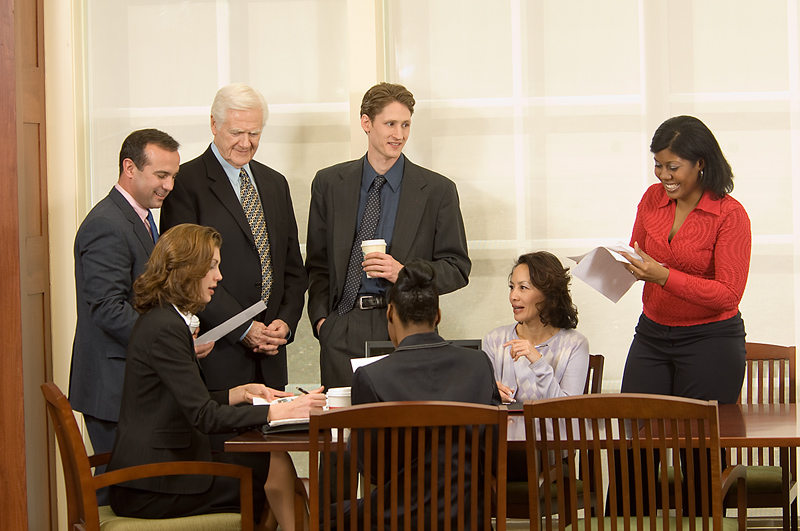
You’re in your seat, on time for once. So, where is everyone else? Slowly, others start arriving, one at a time, the last at about eight minutes after the meeting was supposed to start. No agenda? Too bad.
Once again, it’s business as usual: nothing accomplished. You just wasted 45 minutes, and that’s time you will never get back.
Does that remind you of the last meeting you attended?
London School of Economics and Harvard University researchers report that business leaders spend 60 percent of their time in meetings, and only 15 percent working alone. So with the majority of your work time spent in business meetings, how can you make them more productive?
Andrea Driessen, Chief Boredom Buster at No More Boring Meetings, shares her top 10 tips for team meetings.
1. Be a know-it-all
It’s natural to disengage when meeting content isn’t relevant. The most effective meeting hosts review all potential agenda segments to determine whether they apply to all attendees. If participants already know a particular content slice, then simply don’t cover that segment for the broader audience. Or if you have vastly different levels of awareness in the room, divide people accordingly to ensure maximum relevance for all.
2. No problem? No meeting!
We often make meetings habitual: the weekly project check-in, the monthly mandated. Yet many of these less-than-productive meetings could be canceled or shortened if we identified the problem the meeting is intended to solve. And if we can’t find an identifiable problem, then don’t have the meeting. Sometimes, it’s that simple.
3. Get real
We’ve all suffered through long, boring meetings that try to do too much in too little time. When deciding what you’ll cover, be realistic. If you only have 60 minutes, can you really address 13 separate items? What can be relegated to email or to a one-on-one?
4. Prioritize, prioritize, prioritize!
To save time and solve your most pressing problems, address the most important issues first. Sound obvious? Common sense isn’t always common.
5. Play “pass the pad” to avoid late arrivals
Meeting productivity suffers when people arrive late, and the punctual are penalized. Jon Petz, author of Boring Meetings Suck, recommends playing “pass the pad.” Start every meeting right on time. Hand the last person to arrive a pad of paper, or an electronic device, and voila: He or she is the meeting note-taker. Anyone who arrives later is passed the pad, and so on. People learn quickly that they can either be on time, or become the dreaded note-taker if they are late. As host, you’ll see positive behavior change with little effort on your part.
6. Be a meeting bouncer
A common meeting malady: the tangent talker. Crack down on curve balls by naming a tangent officer who monitors and records tangents for later. Use that parking lot! And you can lighten it up by using a toy police badge.
7. Make it multi-sensory
All meeting content need not be delivered via the spoken word or the dreaded slide deck. We are inherently more engaged when our bodies, not just our frontal lobes, are involved. Here are some ways you can involve the whole person:
- Graphic illustration, in which someone draws out ideas in real time
- Customer testimonials that emotionally inspire
- Quizzes and games
- Product demos
- Surprise guests
- Props that foster kinesthetic learning
8. PPPPP
We know proper planning prevents poor performance (PPPPP). So meeting hosts and attendees will advance their careers by fully preparing before meetings. As host, assign preparatory reading and projects so precious meeting time is focused on what truly requires realtime collaboration. Besides, the more skin we all have in the game, the more likely we are to own and be accountable to group outcomes.
9. Hire an “accountant”
Ever return from a meeting and thought, “We keep talking about making positive changes, yet we keep ending up back in about the same place”? It’s all too common because most meetings lack built-in accountability structures.
Andrea’s Post-Program Pair Up format readily boosts attendees’ accountability and results. Simply pair participants and explain that they’ve just met their “accountability buddy.” Then ask everyone to record at least one goal related to the meeting that they’ll commit to completing in the next week or month, and have them check in with one another.
Teams gain measurable accountability, and you get recognized for generating stronger results tied to your meetings.
10. Remember: humor is no joke
The power of humor — if used effectively within the meeting mix — is no laughing matter. Indeed, there is a strong business case to be made for laughing while learning.
Relevant levity adds critical mental breaks and fosters creativity. Leaders who engage with humor are often considered more “followable.” Humor lowers stress because it releases “feel-good” dopamine and sends more oxygen to blood vessels. It opens our minds and lowers our defenses. After all, how often have you laughed with your arms crossed?! And when participants’ brains are open, they can naturally put more in them.



